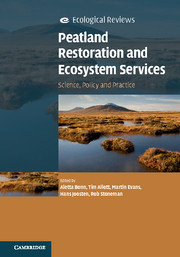Book contents
- Frontmatter
- Contents
- List of contributors
- Foreword
- Acknowledgements
- 1 Peatland restoration and ecosystem services: an introduction
- Part I Peatland ecosystems services
- 2 Peatlands across the globe
- 3 Peatland biodiversity and its restoration
- 4 The role of peatlands in climate regulation
- 5 Peatland restoration and hydrology
- 6 Peatlands as knowledge archives
- 7 Peatlands and cultural ecosystem services
- 8 Peatlands and climate change
- Part II Perspectives on peatland restoration
- Part III Socio-economic and political solutions to managing natural capital and peatland ecosystem services
- References
- Index
7 - Peatlands and cultural ecosystem services
from Part I - Peatland ecosystems services
Published online by Cambridge University Press: 05 June 2016
- Frontmatter
- Contents
- List of contributors
- Foreword
- Acknowledgements
- 1 Peatland restoration and ecosystem services: an introduction
- Part I Peatland ecosystems services
- 2 Peatlands across the globe
- 3 Peatland biodiversity and its restoration
- 4 The role of peatlands in climate regulation
- 5 Peatland restoration and hydrology
- 6 Peatlands as knowledge archives
- 7 Peatlands and cultural ecosystem services
- 8 Peatlands and climate change
- Part II Perspectives on peatland restoration
- Part III Socio-economic and political solutions to managing natural capital and peatland ecosystem services
- References
- Index
Summary
The importance of cultural ecosystem services
This chapter argues that peatlands across the world provide many types of cultural ecosystem services, and so these should be reflected in peatland management. Chapters 2–5 and 17 convincingly demonstrate how peatlands provide essential provisioning and regulating services, but as human well-being is a multi-dimensional concept (UNDP 2010), it is important that we recognise and support the role that nature can play in meeting other needs as leisure, religiosity, identity and freedom (Church, Burgess and Ravenscroft 2011).
Although this idea is (arguably) easy to relate to intuitively, it has proved challenging to articulate a precise and comprehensive definition of cultural ecosystem services (Daniel et al. 2012). The European CICES classification for ecosystem services (Chapter 1) describes them as: ‘the provision of non-material benefits, such as opportunities for recreation, spiritual and aesthetic experiences as well as the gaining of information and knowledge’. This definition is useful as it embraces everything from symbolic (aesthetic and spiritual meanings) to experiential (derived from more physical experiences, such as recreation, community activities) and intellectual benefits (such as scientific research and knowledge-building). The idea of non-material benefits offers a useful way to start thinking about cultural services, but it should not be interpreted strictly binding: as examples in this chapter show, culture can drive consumptive use while virtually all services that provide material services have cultural dimensions.
We begin by discussing some of the current challenges in understanding of peatland cultural services, before going on to explain and provide detail of the varied and interconnected ways in which peatlands provide cultural ecosystem services, and the implications for management.
Challenges for describing the value of cultural ecosystem services
The properties of cultural services mean that it is often difficult to measure their importance in monetary terms (Abson and Termansen 2011). First, many are ‘non-material’ uses that do not entail consumption (harvesting) of the resources – as for aesthetic appreciation of a peatland landscape – and these are typically not valued in conventional markets. Second, many goods in this category are ‘common goods’ or ‘public goods’, where it is hard to exclude users or charge for use. Third, many cultural services and benefits are interconnected with each other, and with other ecosystem services (Chan, Satterfield and Goldstein 2012). Chapter 16 in this volume provides a detailed discussion of valuation challenges.
- Type
- Chapter
- Information
- Peatland Restoration and Ecosystem ServicesScience, Policy and Practice, pp. 114 - 128Publisher: Cambridge University PressPrint publication year: 2016
- 5
- Cited by

